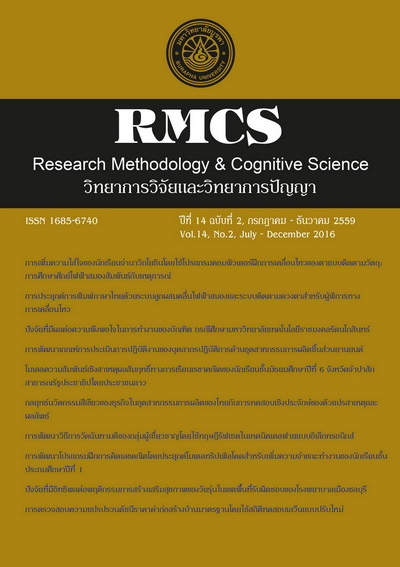โมเดลความสัมพันธ์เชิงสาเหตุผลสัมฤทธิ์ทางการเรียนเรขาคณิตของนักเรียนชั้นมัธยมศึกษาปีที่ 6 จังหวัดจำปาสัก สาธารณรัฐประชาธิปไตยประชาชนลาว
Main Article Content
Abstract
การวิจัยนี้มีวัตถุประสงค์เพื่อพัฒนาโมเดลความสัมพันธ์เชิงสาเหตุผลสัมฤทธิ์ทางการเรียนเรขาคณิตของนักเรียน
และตรวจสอบความสอดคล้องของโมเดลกับข้อมูลเชิงประจักษ์ ตัวแปรในโมเดลประกอบด้วย ตัวแปรแฝง 5 ตัว
ได้แก่ มิติสัมพันธ์เชิงการมองภาพ มิติสัมพันธ์เชิงทิศทาง มิติสัมพันธ์เชิงสัมพันธ์ การหยั่งรู้เชิงเรขาคณิตและผลสัมฤทธิ์
ทางการเรียนเรขาคณิต กลุ่มตัวอย่างเป็นนักเรียนชั้นมัธยมศึกษาปีที่ 6 ของจังหวัดจำปาสัก ส.ป.ป.ลาว ซึ่งกำลังศึกษาภาคเรียนที่ 1 ปีการศึกษา 2558 จำนวน 400 คน เลือกกลุ่มตัวอย่างโดยวิธีการสุ่มหลายขั้นตอน เครื่องมือที่ใช้ในการวิจัย ได้แก่ แบบทดสอบความสามารถด้านมิติสัมพันธ์ แบบทดสอบการหยั่งรู้เชิงเรขาคณิต และแบบทดสอบวัดผลสัมฤทธิ์ทางการเรียนเรขาคณิต วิเคราะห์ค่าสถิติพื้นฐานโดยใช้โปรแกรม SPSS ตรวจสอบคุณภาพของข้อคำถามโดยใช้โปรแกรม TAP (Test Analysis Program) และวิเคราะห์โมเดลความสัมพันธ์เชิงสาเหตุด้วยโปรแกรม LISREL 8.80
ผลการวิจัยปรากฏว่า โมเดลความสัมพันธ์เชิงสาเหตุผลสัมฤทธิ์ทางการเรียนเรขาคณิตที่พัฒนาขึ้น มีความสอดคล้องกับข้อมูลเชิงประจักษ์อยู่ในเกณฑ์ดี พิจารณาจากค่าสถิติไค-สแควร์ เท่ากับ 97.98 ค่า df เท่ากับ 88 ค่าความน่าจะเป็น (p) เท่ากับ .22, ดัชนี GFI เท่ากับ .97 ค่า RMSEA เท่ากับ .02 และค่าสัมประสิทธิ์การพยากรณ์ของผลสัมฤทธิ์ทางการเรียนเรขาคณิตของนักเรียนชั้นมัธยมศึกษาปีที่ 6 เท่ากับ .53 มิติสัมพันธ์เชิงสัมพันธ์มีอิทธิพลทั้งทางตรงและทางอ้อมเชิงบวกต่อผลสัมฤทธิ์ทางการเรียนเรขาคณิต โดยส่งผ่านการหยั่งรู้เชิงเรขาคณิต ส่วนมิติสัมพันธ์เชิงการมองภาพและมิติสัมพันธ์เชิงทิศทางมีอิทธิพลทางอ้อมเชิงบวกต่อผลสัมฤทธิ์ทางการเรียนเรขาคณิต โดยส่งผ่านการหยั่งรู้เชิงเรขาคณิต และการหยั่งรู้เชิงเรขาคณิตมีอิทธิพลทางตรงเชิงบวกต่อผลสัมฤทธิ์ทางการเรียนเรขาคณิต
สรุปได้ว่า โมเดลที่พัฒนาขึ้นมีความสอดคล้องกับข้อมูลเชิงประจักษ์ และตัวแปรที่ส่งผลต่อผลสัมฤทธิ์ทางการ
เรียนเรขาคณิตมากที่สุด คือ การหยั่งรู้เชิงเรขาคณิต รองลงมา ได้แก่ มิติสัมพันธ์เชิง การมองภาพ มิติสัมพันธ์เชิง
สัมพันธ์ และมิติสัมพันธ์เชิงทิศทาง ตามลำดับ
The purpose of this research was to develop and validate a causal relationship model of
geometrical achievement. The model comprises, five latent variables: Spatial visualization, spatial orientation, spatial relation, intuitive geometry, and geometrical achievement. The sample was recruited from 400 grade eleven students (first semester of academic year 2015) in Champasak Province, Lao People’s Democratic Republic. The sample was selected by multi-stage random sampling. The research instruments included Spatial Ability test, Intuitive Geometry test, and Geometrical Achievement test. Descriptive statistics analysis was generated using SPSS, item quality analysis was conducted using TAP (Test Analysis Program), and causal relationship model was analyzed using LISREL 8.80.
Results indicated that the causal model of geometrical achievement was consistent with the empirical data: Chi-square test of goodness of fit = 97.98, df = 88, p = .22, GFI = .97, RMSEA = .02. The variables in the model accounted for 53% of the variance in geometrical achievement. Spatial visualization and spatial orientation had a positive direct effect on intuitive geometry. Spatial relation had a positive direct and indirect effect on geometrical achievement. Intuitive geometry had a positive direct effect on geometrical achievement. In conclusion, intuitive geometry was the main causes influencing of geometrical achievement followed by Spatial Visualization, Spatial Relation, and Spatial Orientation, respectively.
Article Details
References
กระทรวงศึกษาธิการและกีฬา ส.ป.ป.ลาว. (2011). หลักสูตรการศึกษาชั้นมัธยมศึกษาตอนปลาย.กระทรวงศึกษาธิการและกีฬา.
ปริญญา เรืองทิพย์ และเดชา วรรณพาหุล. (2557). การพัฒนาความสามารด้านมิติสัมพันธ์ของนักเรียนชั้นมัธยมศึกษาตอนปลาย โดยการเล่นเกมชุโดะกุ. วารสารราชนครินทร์, 11 (25), 35-41.
พัชรี คุณค้ำชู. (2555). ประสาทวิทยาศาสตร์ประยุกต์.กรุงเทพฯ: สำนักพิมพ์มหาวิทยาลัยธรรมศาสตร์.
Babaei, A., Chaiichi-Mellatshahi, M., & Najafi, M. (2012). Intuition and its effects on mathematical learning. Indian Journal of Science and Technology, 5(7), 3069-3072.
Clements, D. H., & Battista, M. T. (1992). Geometry and Spatial Reasoning. In D. Grouws (Ed.), Handbook of Research on Mathematics Teaching and Learning. New York: Macmillan Publishing Co, Inc.
Dehaene, S. (2011). Section IV - Origins of ProtoMathematical Intuitions.In S. Dehaene, & E. M. Brannon (Eds.), Space, Time, and Number in the Brain (p. 187). San Diego: Academic Press.
Dehaene, S., Izard, V.r., Pica, P., & Spelke, E. (2006). Core Knowledge of Geometry in an Amazonian Indigene Group. Science, 311(1),381-384.
Fujita, T., Jones, K., & Yamamoto, S. (2004). The Role of Intuition in Geometry Education: Learning from the Teaching Practice in the early 20th Century. In 10th International Congress on Mathematical Education (ICME-10) 4-11 July 2004, (pp. 1-15). Denmark: Copenhagen.
Giofrè, D., Mammarella, I.C., Ronconi, L., & Cornoldi, C. (2013). Visuospatial working memory in intuitive geometry, and in academic achievement in geometry. Learning and Individual Differences, 23, 114-122.
Goldstein, E. B. (2011). Cognitive Psychology: Connecting mind, Research, and Everyday experience(3rd ed.). USA: Wadsworth, Cengage Learning.
Hannafin, R. D., Truxaw, M. P., Vermillion, J. R., & Liu, Y. (2008). Effects of spatial ability and instructional program on geometry achievement. The Journal of Educational Research, 101(3), 148-156.
Kalogirou, P., & Gagatsis, A. (2011). A first insight of the relationship between students’ spatial ability and geometrical figure apprehension. Acta Didactica Universitatis Comenianae Mathematics, 11, 27-39.
Lubinski, D. (2010). Spatial Ability and STEM: A sleeping giant for talent identification and development. Personality, and Individual Differences, 49(4), 344-351.
National Research Council. (2001). Adding it up: Helping children learn mathematics.In J. Kilpatrick, J. Swafford, & B. Findell (Eds.). Mathematics Learning
Study Committee, Center for Education, Division of Behavioral and Social Sciences and Education. Washington, DC: National Academy Press.
Olkun, S. (2003). Making connections: Improving spatial abilities with engineering drawing activities. International Journal of Mathematics Teaching, and Learning, 3(1),1-10.
Papageorgiou, P., Monoyiou, A., & Pitta-Pantazi, D. (2006). The Intuitive Rule More A-More B: The Impact of a Dynamic Geometry Software.J. Novotná, H. Moraová, M. Krátká, & N. Stehlíková, (Eds.). In
Proceedings 30th Conference of the International Group for the Psychology of Mathematics Education. Prague: PME.
Pittalis, M., & Christou, C. (2010). Types of reasoning in 3D geometry thinking and their relation with spatial ability. Educational Studies in Mathematics,75 (2), 191-212.
Spelke, E. S. (2011). Chapter 18 - Natural Number, and Natural Geometry.In S. Dehaene & E. M. Brannon (Eds.), Space, Time, and Number in the Brain. San Diego: Academic Press.
Sternberg, R. J. (2014). Advances in the psychology of human intelligence (4th ed). Psychology Press.
Ung, P., Kornpetpanee, S., & Suksawang, P. (2011). Influence of self-regulation and perceived selfefficacy in mathematics on anxiety of upper secondary school students in Kingdom of Cambodia. Research Methodology & Cognitive Science, 9(1), 99-111.
Verstijnen, I. M., Leeuwen, C. V., Goldschimdt, G., Haeml, R., & Hennessey, J. M. (1998). Creative discovery in imagery, and perception: combining is relatively easy, restructuring takes a sketch.
Acta Psychologica, 99(2), 177–200.
Wai, J., Lubinski, D., & Benbow, C. P. (2009). Spatial Ability for STEM domains: Aligning over 50 years of cumulative psychological knowledge solidifies its importance. Journal of Educational Psychology, 101(4), 817–835.
Weckbacher, L. M., & Okamoto, Y. (2014). Mental rotation ability in relation to self-perceptions of high school geometry. Learning, and Individual Differences, 30, 58-63.
